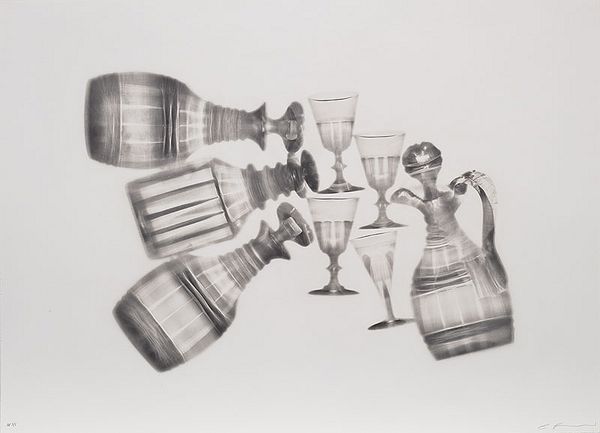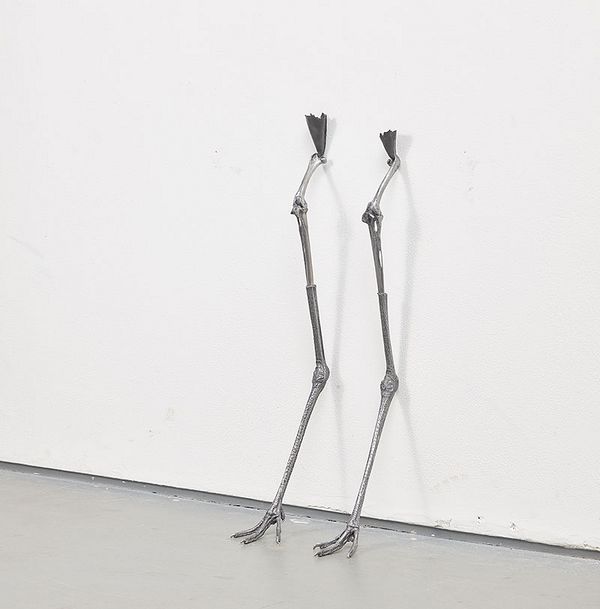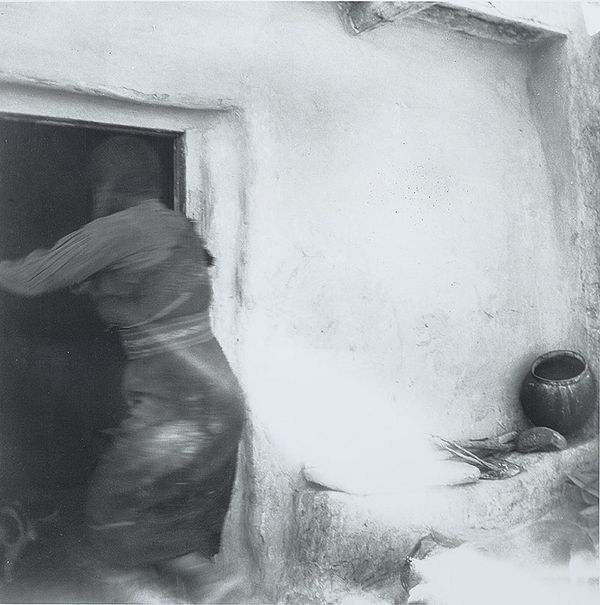Goshka Macuga, Untitled 5 (Aby Warburg Photograph, April 1896, Pueblo woman escaping into her house at the sight of Warburg’s camera), 2008. 20th Century & Contemporary Art London.
Phillips is proud to present a series of works at auction as par of the 4 March 20th Century & Contemporary Art Day Sale in London to support The Warburg Renaissance, a capital transformation project that will create in London’s 21st-Century Knowledge Quarter the interdisciplinary laboratory that founder Aby Warburg dreamed of in early 20th-century Hamburg. We spoke with three artists whose work features in the collection about the unique ways the institute has inspired their practices and understanding of cultural memory.
PHILLIPS: What does The Warburg Institute (and the work of Aby Warburg) mean to you?
Michael Joo: A living temple to the vision of an intellectual and artistic practice that uses history to acknowledge and create new pathways to the histories yet unacknowledged and unwritten; a place of learning and the energy generated by this.
Cornelia Parker: My first brush with art history was when I was 15 years old and was taught by my art teachers, knowledge gleaned from Gombrich’s The Story of Art. A seed was planted in my imagination, a catalyst that propelled me towards a career in art. In 1999, I was invited to make an exhibition at the Warburg by Penelope Curtis. She wanted to show some of my Avoided Objects, which were small works using non objects. For instance, The Negatives of Words used residue excavated when carving words into silver by hand. Similarly, Collected Death of Images was made from sheets of silver reclaimed from photographic fix. I always think of the Warburg Institute as a perfect, quiet place to absorb culture, so it was a good fit.
Goshka Macuga: Aby Warburg is an important figure to me. Having been first introduced to his work years ago before working on my project for Kunsthalle Basel, Warburg’s work and persona has had a lasting impact on me, particularly his relationship to knowledge. More widely, Warburg has had a great influence, not only on artists and scholars, but also on people who are generally interested in knowledge. The institute’s role in keeping the personal story of Warburg’s life and the history of his collection in London preserved is a great one, as a testament, not only to the history of Europe from the 19th -21st centuries, but also as something with more global significance.
P: Tell us a bit about the work you’ve donated and why you chose it.
CP: I have chosen one of my photogravures for my donation to the Warburg auction. I made it using glassware that belonged to the pioneer of photography Fox Talbot. He had made a famous image of his Articles of Glass in 1844. Of nineteen pieces of glassware only eight remain, the others lost or broken. The Bodleian Library in Oxford houses those that are left. I made a request to borrow the glass and made a series of photogravures using them as a kind of glass negative. Breaking with Talbot’s formal approach, my compositions are somewhat more animated.
MJ: DRWN is from a series of works involving animals that live in or migrate through contested territories, borders and de-militarized zones. Though these liminal spaces are constructs, the particular ecosystems that form inside them and at their edges are very real. This artwork presents the legs from an endangered crane specimen that are cast in an aluminum and graphite composite; one, from a direct cast and the other its 3D-scanned and reverse-printed doppelganger. The work is installed from a height, tracing the wall’s surface on the way to the pair's final position on the floor. Each time they are installed, a trace of them is left behind, slowly contributing to their physical dissolution as indicated by the marks left on the wall above each cast. For me, the act of doing in order to see, and its requisite complication of the present and future seemed to have some resonance in my thinking about Aby Warburg and the Institute.
GM: I’m donating a photograph taken by Aby Warburg in 1896 at the Hopi village during his trip to the region of the Pueblo Indians in North America. This image was featured in my exhibition at the Kunsthalle Basel in 2009, I am Become Death. I am donating this work to the auction to support The Warburg Institute’s plans for the upcoming renovation of the building. The funds raised through the auction could support transcription, translation and digitization of the Warburg’s collection to make parts of the Institute more accessible to the public.

Cornelia Parker, Fox Talbot's Articles of Glass (all that are left), 2016. 20th Century & Contemporary Art London.
P: How does history inform your art?
MJ: In my work, I like drawing from biased historical narratives and complicating them with complex material identities that contain their own timelines and facts. Perhaps it’s possible that these collisions of human and a-human truths and priorities can generate entangled relationships and new narratives of existence and co-existence on our planet.
GM: My Kunsthalle Basel show combined different strands of historical and artistic research, reflecting on Aby Warburg’s trip in the USA in 1895-96 and the Robert Morris exhibition Bodyspacemotionthings at the Tate in 1971, as well as Herbert Bayer’s Road to Victory exhibition in 1942. Through this path I tried to access different moments in time and different political stances closely related to the neo-colonial history of the United States of America. Warburg’s trip to the US directly linked with the expansion of the American Frontier in the 19th Century. Road to Victory helped to summarize U.S influence, during and post-WWII. The work of Robert Morris allowed me to draw parallels between American Wars, starting from the Vietnam War to more contemporary conflicts. I also followed the steps of Aby Warburg and traveled to the Native American Hopi tribe reservation in New Mexico as part of my research for the making of Snake Society.
P: How do you see the relationship between books and images?
GM: Warburg’s last, unfinished project was a “picture atlas” arranged on forty screens, titled by him: Mnemosyne. The Atlas, designed to serve as a storyboard or mnemonic device, was the culmination of forty years of his intellectual development and to this day remains as enigmatic as it was in 1929. The subjective narrative illustrated by a juxtaposition of images and texts carried deep symbolic value and until his death was open to continued rearrangements and updates, sparked by events such as the signing of the concordat with Mussolini or news of Eckener’s Zeppelin docking in New York.
MJ: The acts of reading or writing involve an image making that can be explicit or fluid. Since these are just beyond space as we experience it, they are not fixed by material limitations and laws of the physical world. I’m drawn to the tension of this “un-fixedness” in relation to sculpture. Reading itself calls for a personal relationship to the material presented which, when combined with human experience and day-to-day life, can transform information to knowledge in an act of intellectual alchemy. Knowledge itself as an art medium is a contemporary, relevant and essential thing to consider in this day and age. The use of data to generate artforms if guided by the right algorithms, can speak to this.

Michael Joo, DRWN (Carunculatus) AI 2, 2015. 20th Century & Contemporary Art London.
P: Are there any texts that have inspired your practice?
GM: My second project – the script for Preparatory Notes for a Chicago Comedy, developed by Dieter Roelstraete and I – was based on my findings in The Warburg Institute Archive in London. While researching there in 2007, I came across information that Warburg wrote a play critiquing the art scene in Hamburg – his hometown. In his script, titled Hamburg Conversations on Art: Hamburg Comedy, characters (possibly resembling the members of his own family and friends) discussed or argued matters related to contemporary art at the time. The original text in the archive was in German, handwritten by Warburg. We had to translate it to English, using the essence of Warburg’s text to write our own script, reflecting on the global contemporary art scene today.
P: The Warburg Institute is a place of cultural memory – what role do you think memory plays in art?
MJ: Memory is foundational in establishing the reference markers to navigate society and the world and gives us a sense of autonomy and identity. At its most complex, I see it as a non-structural framework, perhaps like a grid in space containing all one has experienced, whether maker or viewer, which when superimposed onto the artwork or its process, helps to establish different constellations of meaning between image or object and the way we think the world works. At its most basic, it can serve as an unattainable ideal in the process of making an image or object; always on the tip of one’s tongue and fingertips and generative of something beyond representation.
GM: Memory is fundamental in human existence as it determines how we link past events with the present as well as the future. In art, memory not only exists as a subject of research, but also as a tool, an important mechanism essential in building structures that reflect the complexities of our individual and social existence. Memory is what unites us in the sharing of pain and pleasure, as well as in our basic ability to relate to each other and our environment.
The Warburg Institute primarily consists of image-based materials, carefully assembled by Warburg himself and put to work in projects such as Mnemosyne Atlas. In a similar way to Giordano Bruno’s Memory Wheels, Robert Fludd’s architectural visualization or Ramon Lull’s alchemical diagrams, Warburg’s Atlas can be seen as a complex system of ideas that reflect not only the history of art, but also the shared psyche of his time. The Warburg Institute has been instrumental in research and studies for art historians and visual artists and stands as a monument or a structure of knowledge that feeds cultural memory in its own right. One of the most elaborate and inspiring studies of the history of memory systems (by Francis A. Yates in The Art of Memory) is unsurprisingly affiliated with the Warburg Institute:
“Though the mnemotechnical side of the art is always present, both in antiquity and thereafter, and forms the factual basis for its investigation, the exploration of it must include more than the history of its techniques. Mnemosyne, said the Greeks, is the mother of the Muses; the history of the training of this most fundamental and elusive of human powers will plunge us into deep waters.”
Discover More from 20th Century & Contemporary Art >
Recommended Reading
Two Studies in Intimacy: Henry Moore & Jean Dubuffet >
